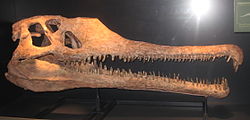アンギストリヌス
アンギストリヌス(学名:Angistorhinus)[1]は、アメリカ合衆国のテキサス州とワイオミング州の上部三畳系から化石が産出している、絶滅した植竜類の属[2]。長い吻部や皮骨板といったワニに類似した外見を持ち、半水棲の生活を送っていた[1]。
| アンギストリヌス | |||||||||||||||||||||||||||
|---|---|---|---|---|---|---|---|---|---|---|---|---|---|---|---|---|---|---|---|---|---|---|---|---|---|---|---|
 アンギストリヌスの頭蓋骨
| |||||||||||||||||||||||||||
| 地質時代 | |||||||||||||||||||||||||||
| 後期三畳紀 | |||||||||||||||||||||||||||
| 分類 | |||||||||||||||||||||||||||
| |||||||||||||||||||||||||||
| 学名 | |||||||||||||||||||||||||||
| Angistorhinus Mehl, 1913 | |||||||||||||||||||||||||||
| 種 | |||||||||||||||||||||||||||
|
説明
編集アンギストリヌスは初期の植竜類の属の1つである。形態は同じく初期のパラスクスと類似するが、鼻孔がより後側に位置して目の直前に近い点で異なる。これは後期の全ての植竜類を特徴づける特殊化した形質状態である。アンギストリヌスはどの基準に基づいても巨大な動物であった。頭蓋骨長は一般に約120センチメートルであり、全長は8メートルに達したと推定される。後述する A. megalodon はより大型であり、短く重厚な吻部を持つことから別属ブラキスクスとして扱われる場合もある。本種の大きさは全ての現生のワニを上回るものであった[3]。
分類
編集アンギストリヌスは1913年にMehlが最初に命名しており、タイプ種はAngistorhinus grandis である[4]。テキサス州とワイオミング州から産出した他の種としては A. alticephalus (Stovall and Wharton, 1936)、A. gracilis (Mehl, 1915) 、A. maximus (Mehl, 1928)が居るが、これらはタイプ種と同種である[5]。アンギストリヌスの標本は、ワイオミング州のChugwater層群 Popo Agie 層から回収されたものでは、部分的な頭蓋骨と下顎であるホロタイプ標本 UC 631 と、部分的な頭蓋骨であり関連するパラタイプ標本 UM 531 が知られる。テキサス州のDockum層から回収されたものでは、頭蓋骨と下顎の TMM 31098-1、部分的な頭蓋骨と下顎の ROM 7977 が知られる。モロッコの三畳系から産出した A. talainti は本属の第二の種である可能性がある[2]。
1995年、Long と Murry はブラキスクスのシニアシノニムとして Angistorhinus megalodon という新たな組み合わせを提唱している[6]。また、Hungerbühler and Sues (2001) はアンギストリヌスがルーティオドンのジュニアシノニムであるとの仮説を立てている[7]。しかし2010年に Michelle R. Stocker は継続してブラキスクスを有効な属、A. grandis として扱っている[8]。
系統
編集以下のクラドグラムはKammerer et al. (2016)に従い、植竜類の類縁関係を示す[9]。
| パラスクス科 |
| |||||||||||||||||||||||||||||||||||||||||||||||||||||||||||||||||||||||||||||||||||||||||||||||||||||||||
出典
編集- ^ a b 小林快次『ワニと恐竜の共存 巨大ワニと恐竜の世界』北海道大学出版会、2013年7月25日、9頁。ISBN 978-4-8329-1398-1。
- ^ a b Dutuit, J.-M. (1977). “Description du craˆne de Angistorhinus talainti n. sp. un nouveau Phytosaure du Trais atlasique marocain”. Bulletin du Muséum National d'Histoire Naturelle 3 (489): 297–336.
- ^ “Palaeos Mesozoic: Triassic: Late Triassic: Carnian - 2”. 2013年12月24日時点のオリジナルよりアーカイブ。2012年5月25日閲覧。
- ^ Mehl, M. G. (1913). “Angistorhinus, a new genus of Phytosauria from the Trias of Wyoming”. Journal of Geology 21 (2): 186–191. Bibcode: 1913JG.....21..186M. doi:10.1086/622049.
- ^ S. G. Lucas; A. B. Heckert & R. Kahle (2002). A. B. Heckert & S. G. Lucas. eds. “Postcranial anatomy of Angistorhinus, a Late Triassic phytosaur from West Texas”. Upper Triassic Stratigraphy and Paleontology, New Mexico Museum of Natural History and Science Bulletin 21: 157–164.
- ^ Long, R. A. & Murry, P. A. (1995). “Late Triassic (Carnian and Norian) tetrapods from the southwestern United States”. Bulletin of the New Mexico Museum of Natural History and Science 4: 1–254.
- ^ Hungerbühler, A. & Sues, H.-D. (2001). “Status and phylogenetic relationships of the Late Triassic phytosaur Rutiodon carolinensis”. Journal of Vertebrate Paleontology 21 (3 Suppl): 64A. doi:10.1080/02724634.2001.10010852.
- ^ Michelle R. Stocker (2010). “A new taxon of phytosaur (Archosauria: Pseudosuchia) from the Late Triassic (Norian) Sonsela Member (Chinle Formation) in Arizona, and a critical reevaluation of Leptosuchus Case, 1922”. Palaeontology 53 (5): 997–1022. doi:10.1111/j.1475-4983.2010.00983.x.
- ^ Christian F. Kammerer; Richard J. Butler; Saswati Bandyopadhyay; Michelle R. Stocker (2016). “Relationships of the Indian phytosaur Parasuchus hislopi Lydekker, 1885”. Papers in Palaeontology 2 (1): 1–23. doi:10.1002/spp2.1022.